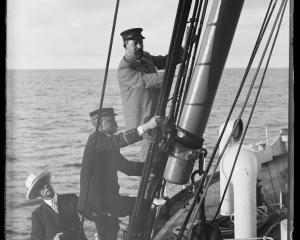
Hidden in the back streets of Hampden, surrounded by trees and chickens, there is a shed covered in free-form shapes guarded by strange sculptures.
The expressive figures seem stone-like and Gaudi-esque.
The creator is a reclusive man, who spends most of his days caring for his garden, looking after his animals and playing guitar.
But when he gets a spare moment, Rick mixes shredded paper in a cocktail of water, sand and concrete.
Once combined, the porridge-like medium gets slapped on to the walls with reckless abandon.
It’s not the first time I’ve seen my Dad make papercrete.
For more than 15 years Rick Koehler has used the home-made substance for various DIYs and art projects.
He’s never used a recipe, but I asked him to give me one.
Dad fills a container with roughly half paper, a-quarter sand and a-quarter concrete powder.
He starts by soaking the shredded paper and softening it until it becomes a formless slop.
Sand and concrete powder is then added and mixed.
The sand, which he acquires from the beach, is sifted through a piece of chicken wire to stop the big rocks.
Mix it all together. Once it looks like an unappetising bowl of oatmeal, your papercrete is done.
The warm and slightly lumpy mixture is best if you squeeze it to get the water out and flatten it into a pancake for easy application.
Rick liked the material because of its "stickability".

"That’s kind of why I fell in love with it, because it sticks like s... to a blanket."
It was able to adhere to the corrugated iron walls of his shed.
He said papercrete was similar to cob, which was made with sand, clay and straw.
He had experimented with multiple iterations of the recipe — some without sand, some with clay instead of concrete and some with just paper and clay.
Rick’s largest papercrete project spans the entirety of his shed, with faces, shapes and shelves decorating it inside and out.
There are also benchtops, garden edging and various sculptures of funky fellas.
Despite making papercrete numerous times, Dad and I whipped up a batch for his newspaper debut.
With our mush complete, we started covering a piece of wall together, using our bare hands to squish the substance on.
Dad said it was best to wear gloves, but he had run out.
He was unfazed by the drying and abrasive effects of papercrete but my eczema-prone skin was suffering for days.
As I worked on the wall, he prepared another project, because he always worked on too many things at once,
He stapled chicken wire on an old wooden tray, which would provide the frame for his latest art piece.
We covered the form in papercrete, creating something akin to a mounted demon head, but Dad said it still needed to be painted to embody his vision.
That would be a project for another day.
Rick has been making papercrete for as long as I can remember.
It all started because he wanted to find a use for the shredded paper he baled while working at the local resource recovery park.
It made him think about alternative uses for the material.
After some research he found out about papercrete, a low-cost medium he could use to sculpt.
"When I first started doing the shed, I spent nights out here ’til two, three o’clock in the morning because it was so enjoyable."
In the past he had created paper mache sculptures, including large pots, a pig bowl and a duck for his front lawn.
— Arrow Koehler, PIJF reporter












